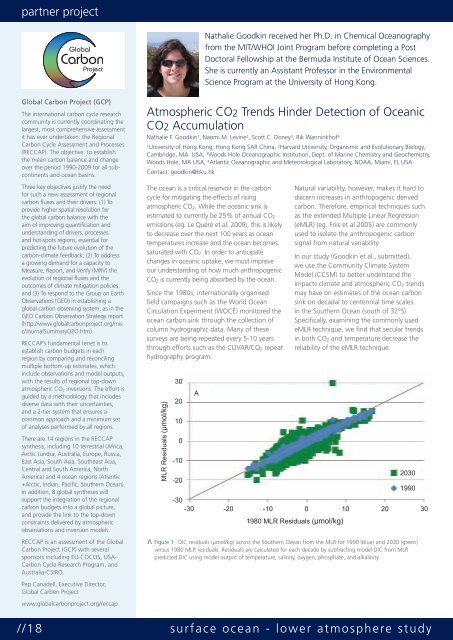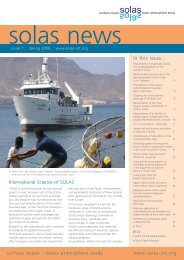SOLAS News 2010
SOLAS News 2010
SOLAS News 2010
- TAGS
- solas
- news
- www.solas-int.org
Create successful ePaper yourself
Turn your PDF publications into a flip-book with our unique Google optimized e-Paper software.
partner project<br />
Global Carbon Project (GCP)<br />
The international carbon cycle research<br />
community is currently coordinating the<br />
largest, most comprehensive assessment<br />
it has ever undertaken: the Regional<br />
Carbon Cycle Assessment and Processes<br />
(RECCAP). The objective: to establish<br />
the mean carbon balance and change<br />
over the period 1990-2009 for all subcontinents<br />
and ocean basins.<br />
Three key objectives justify the need<br />
for such a new assessment of regional<br />
carbon fluxes and their drivers: (1) To<br />
provide higher spatial resolution for<br />
the global carbon balance with the<br />
aim of improving quantification and<br />
understanding of drivers, processes<br />
and hot-spots regions, essential for<br />
predicting the future evolution of the<br />
carbon-climate feedback; (2) To address<br />
a growing demand for a capacity to<br />
Measure, Report, and Verify (MRV) the<br />
evolution of regional fluxes and the<br />
outcomes of climate mitigation policies;<br />
and (3) To respond to the Group on Earth<br />
Observations (GEO) in establishing a<br />
global carbon observing system, as in the<br />
GEO Carbon Observation Strategy report<br />
(http://www.globalcarbonproject.org/mis<br />
c/JournalSummaryGEO.htm).<br />
RECCAP’s fundamental tenet is to<br />
establish carbon budgets in each<br />
region by comparing and reconciling<br />
multiple bottom-up estimates, which<br />
include observations and model outputs,<br />
with the results of regional top-down<br />
atmospheric CO2 inversions. The effort is<br />
guided by a methodology that includes<br />
diverse data with their uncertainties,<br />
and a 2-tier system that ensures a<br />
common approach and a minimum set<br />
of analyses performed by all regions.<br />
There are 14 regions in the RECCAP<br />
synthesis, including 10 terrestrial (Africa,<br />
Arctic tundra, Australia, Europe, Russia,<br />
East Asia, South Asia, Southeast Asia,<br />
Central and South America, North<br />
America) and 4 ocean regions (Atlantic<br />
+Arctic, Indian, Pacific, Southern Ocean).<br />
In addition, 8 global syntheses will<br />
support the integration of the regional<br />
carbon budgets into a global picture,<br />
and provide the link to the top-down<br />
constraints delivered by atmospheric<br />
observations and inversion models.<br />
RECCAP is an assessment of the Global<br />
Carbon Project (GCP) with several<br />
sponsors including EU-COCOS, USA-<br />
Carbon Cycle Research Program, and<br />
Australia-CSIRO.<br />
Pep Canadell, Executive Director,<br />
Global Carbon Project<br />
www.globalcarbonproject.org/reccap<br />
Atmospheric CO2 Trends Hinder Detection of Oceanic<br />
CO2 Accumulation<br />
Nathalie F. Goodkin 1 , Naomi M. Levine 2 , Scott C. Doney 3 , Rik Wanninkhof 4<br />
1University of Hong Kong, Hong Kong SAR China, 2Harvard University, Organismic and Evolutionary Biology,<br />
Cambridge, MA USA, 3Woods Hole Oceanographic Institution, Dept. of Marine Chemistry and Geochemistry,<br />
Woods Hole, MA USA, 4Atlantic Oceanographic and Meteorological Laboratory, NOAA, Miami, FL USA<br />
Contact: goodkin@hku.hk<br />
Nathalie Goodkin received her Ph.D. in Chemical Oceanography<br />
from the MIT/WHOI Joint Program before completing a Post<br />
Doctoral Fellowship at the Bermuda Institute of Ocean Sciences.<br />
She is currently an Assistant Professor in the Environmental<br />
Science Program at the University of Hong Kong.<br />
The ocean is a critical reservoir in the carbon<br />
cycle for mitigating the effects of rising<br />
atmospheric CO2. While the oceanic sink is<br />
estimated to currently be 25% of annual CO2<br />
emissions (eg. Le Quéré et al. 2009), this is likely<br />
to decrease over the next 100 years as ocean<br />
temperatures increase and the ocean becomes<br />
saturated with CO2. In order to anticipate<br />
changes in oceanic uptake, we must improve<br />
our understanding of how much anthropogenic<br />
CO2 is currently being absorbed by the ocean.<br />
Since the 1980s, internationally organised<br />
field campaigns such as the World Ocean<br />
Circulation Experiment (WOCE) monitored the<br />
ocean carbon sink through the collection of<br />
column hydrographic data. Many of these<br />
surveys are being repeated every 5-10 years<br />
through efforts such as the CLIVAR/CO2 repeat<br />
hydrography program.<br />
MLR Residuals (µmol/kg)<br />
30<br />
20<br />
10<br />
0<br />
A<br />
Natural variability, however, makes it hard to<br />
discern increases in anthropogenic derived<br />
carbon. Therefore, empirical techniques such<br />
as the extended Multiple Linear Regression<br />
(eMLR) (eg. Friis et al 2005) are commonly<br />
used to isolate the anthropogenic carbon<br />
signal from natural variability.<br />
In our study (Goodkin et al., submitted),<br />
we use the Community Climate System<br />
Model (CCSM) to better understand the<br />
impacts climate and atmospheric CO2 trends<br />
may have on estimates of the ocean carbon<br />
sink on decadal to centennial time scales<br />
in the Southern Ocean (south of 32°S).<br />
Specifically, examining the commonly used<br />
eMLR technique, we find that secular trends<br />
in both CO2 and temperature decrease the<br />
reliability of the eMLR technique.<br />
-10<br />
2030<br />
-20<br />
1990<br />
-30<br />
-30 -20 -10 0 10 20 30<br />
1980 MLR Residuals (µmol/kg)<br />
Figure 1 : DIC residuals (µmol/kg) across the Southern Ocean from the MLR for 1990 (blue) and 2030 (green)<br />
versus 1980 MLR residuals. Residuals are calculated for each decade by subtracting model DIC from MLR<br />
predicted DIC using model output of temperature, salinity, oxygen, phosphate, and alkalinity.<br />
//18 surface ocean - lower atmosphere study



